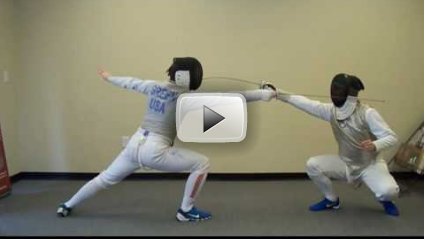Duck and Cover – When is ducking really covering target?
Just when is ducking in foil allowed and when does it constitute covering target? In this brief guide we’ll walk through some video examples of “good” and “bad” ducking to show you a properly executed duck and one that is an infraction and should earn the fencer a yellow card.
Read more to see examples of ducking and covering.
First, we need to look at the rules regarding covering target to know what is an infraction.
Displacing the target and passing the opponent
t.21 Displacing the target and ducking are allowed even if during the
action the unarmed hand comes into contact with the strip….
Substitution and use of the non-sword hand and arm
t.22 The use of the non-sword hand and arm to carry out an offensive or defensive action is forbidden (cf. t.114, t.117, t.120). Should such an offense occur, the touch scored by the fencer at fault is annulled and the latter will be penalized as specified for offenses of the second group (red card).
In foil and saber, it is forbidden to protect the target area or to substitute another part of the body for the target area, either by covering or by an abnormal movement (cf. t.114, t.116, t.120); any touch scored by the fencer at fault is annulled.
The important parts to note are:
- Ducking is specifically allowed in the rules, so you can’t get penalized for simply ducking and ducking (properly) is not an “abnormal action”
- You are not allowed to protect your target area with non-target area by covering or an abnormal movement
- We don’t have a definition of an abnormal movement – it’s much like the Supreme Court definition of pornography: you know it when you see it.
Given that we have an action that is allowed and a case where it could be penalized, how do we draw the line?
In a recent discussion on the Fencing.Net forums, we have a couple of high level referees offering their advice. Omar Bhutta (a level 2 foil referee) proffers:
“ducking at any distance is legal. The head does not cover target any more at one distance than in another; it is just harder to get your weapon into position to hit the front….same as if someone didn’t duck.”
He continues:
“The current application of covering with the head is one of the more challenging rules to apply consistently. At most levels, it is not applied uniformly, which leads to a lot of frustration on the part of most fencers. As a general rule of thumb, if the fencer is looking at their feet, they are probably covering with their head. Their back does not need to be parallel to the ground to cover target. In the same vein, if your back is parallel to the ground, and your head is up, that is not covering target. Please note that simply applying that written statement carte blanche to an active bout will not get 100% of calls right….it is very dynamic and is best illustrated with video/live demonstration.”
Turning to the video, there are two examples from a foil bout that we can look at:
First, here’s a static example of a duck that would not be penalized:
Next, we should look at a live demonstration of how these may look “in the wild”.
This is a 6 minute video, but we’re linking to the specific action, so you only need to watch about 10 seconds to see what we’re talking about.
In the first action, the fencer on the right comes in close and ducks to avoid a touch from left. Note that the head stays up and the mask is never moved to cover target or parry.
Let’s take a look at another portion of this bout (just play about 10 seconds):
In this action, the fencer on the right ducks but also moves the head so that the mask is protecting the front of the torso. The fencer is looking at the floor, not their opponent and the back is parallel to the floor.
The keys to calling a penalty on this action are to determine if the fencer is protecting their valid target with non-valid target. In the case of ducking, a “classic” duck – with the head up and looking at the opponent – is perfectly fine, even if the point lands square on the mask. If, however, the mask is moved in a blocking action or, as in the last clip, used to actively block a target area, it’s an action that should be penalized.
What all foilists should take from this is you can duck, just don’t cover!
